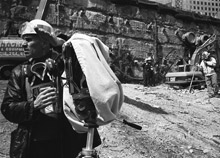
AT GROUND ZERO: “I wanted it to be able to tell . . . what it really looked like inside and I wanted to give people the chance to grieve that you can only do when you’re given a chance to face something.” |
On a quiet Sunday morning a month after the September 11 attacks, I visited the ruins of the World Trade Center. Sidewalk vendors sold Twin Towers souvenirs; firefighters from across the country snapped photos with disposable cameras; clowns, come to perform some sort of grief counseling, wandered around looking stricken. Everyone seemed stunned and exhausted. You couldn’t get close to the wreckage, but looking past parked Humvees and police vans, down empty downtown canyons, you could catch glimpses: a steady jet of water pouring onto still smoking heaps of pretzeled steel, a building that appeared to have been stripped of its façade and torched, the signature shroud of one of the World Trade Center buildings. Surrounding buildings towered over the heap, unscathed save for here and there a ragged 50-foot-long gash 30 stories up. From photos and television I’d known the devastation was massive, but not until I saw it myself and walked the whole perimeter did I feel the scope of it.
Joel Meyerowitz’s new coffee-table tome, Aftermath: World Trade Center Archive (Phaidon, 350 pages, $75), as big and heavy as a tombstone, conveys something of that scope.
Meyerowitz started out as a wily street photographer, but at age 68 he’s best known for his sweet meditative shots of Cape Cod. He keeps a studio in Provincetown, and he was photographing along the Chatham shore on September 11 when his wife called him and told him to get to a television, something terrible had happened. Five days later he walked from his apartment in the West Village to the World Trade Center. He raised his camera to snap a picture and a cop poked him. “This is a crime scene. No photography.”
“Fuck them. They can’t stop me. They can’t stop photography,” Meyerowitz tells me he remembers thinking. “No photography meant no history.” He called around, wrote to the mayor, proposed assembling a team to shoot an official photographic record of the devastation and clean-up. No luck. The Museum of the City of New York wrote him a letter endorsing his presence at Ground Zero (the resulting photos are now part of the museum’s collection), but the cops and soldiers manning its borders refused to let him in. He got in touch with a friend, a honcho at the Parks and Rec Department who got him a worker’s badge and an escort through the barricades. Even so, Meyerowitz was always in danger of being tossed out, so, he says, he dressed like a construction worker, forged passes, and made friends with detectives from the NYPD’s Arson and Explosion Squad, who became his protectors. He returned again and again, taking more than 8000 photographs, assembling what’s billed as the only comprehensive photographic record of the work at Ground Zero.
The 400 photos in Aftermath begin with four placid cityscapes centered on the World Trade Center that Meyerowitz shot between 1983 and September 5, 2001. Paging through them is like being at a horror movie and wanting to holler warnings to kids just going about their business as a monster lurks under the bed. Then the book erupts into panoramas of devastation. Dropped off that first day, Meyerowitz tells me when I call him at his Cape Cod studio, he stood at the foot of the pancaked rubble, eight stories tall and six stories more underground, and thought: “Oh, now I understand why there are no survivors.”
He shot mostly with an unwieldy Deerdorf view camera, exposing 4x5-inch negatives that vacuumed up astonishing detail: tangles of broken girders, dangling cables, bars jutting menacingly from the ground, coils of abandoned fire hose, giant cranes and grapplers. Men in respirators and hardhats pick through the debris; work stops for honor guards to carry out flag-draped scraps of the dead.
“I wanted it to be able to tell everybody on the outside two things, first, what it really looked like inside, because it was a forbidden city, and second, I wanted to give people the chance to grieve that you can only do when you’re given a chance to face something.”